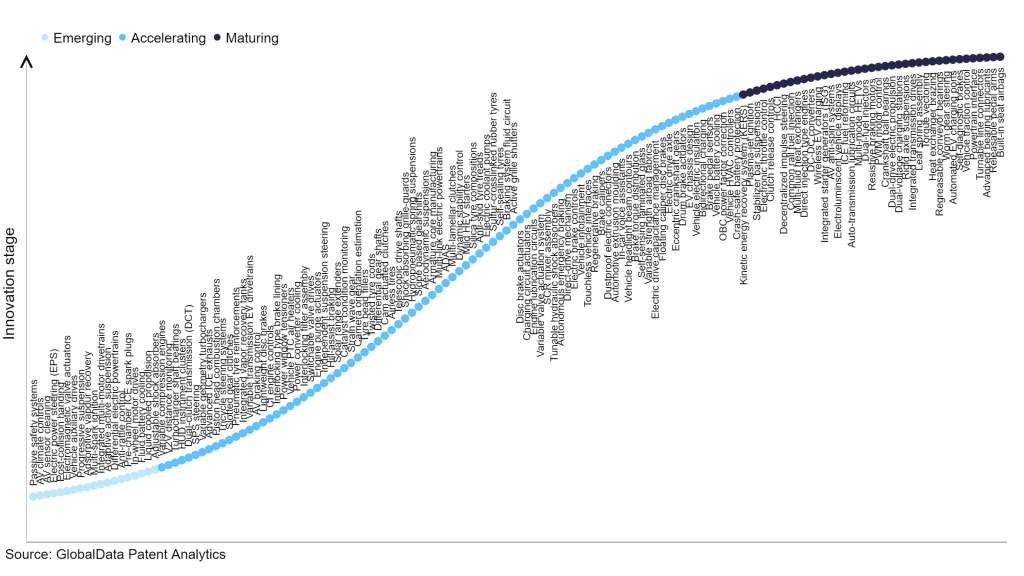The automotive industry continues to be a hotbed of patent innovation. The design of multi-link powertrains allows for better optimization of energy usage, contributing to increased overall efficiency in electric vehicles (EVs). This efficiency is essential for extending the range of EVs on a single charge. Additionally, multi-link powertrains can be designed to integrate regenerative braking systems effectively. This feature captures and converts kinetic energy during braking into electrical energy, improving overall energy efficiency and extending the vehicle’s range. Innovation in multi-link powertrains is driven by growing importance of technologies such as regenerative braking systems, inverter technology, battery thermal management systems, and advanced suspension systems. In the last three years alone, there have been over 1.7 million patents filed and granted in the automotive industry, according to GlobalData’s report on Innovation in automotive: multi-link electric powertrains. Buy the report here.
However, not all innovations are equal and nor do they follow a constant upward trend. Instead, their evolution takes the form of an S-shaped curve that reflects their typical lifecycle from early emergence to accelerating adoption, before finally stabilizing and reaching maturity.
Identifying where a particular innovation is on this journey, especially those that are in the emerging and accelerating stages, is essential for understanding their current level of adoption and the likely future trajectory and impact they will have.
300+ innovations will shape the automotive industry
According to GlobalData’s Technology Foresights, which plots the S-curve for the automotive industry using innovation intensity models built on over one million patents, there are 300+ innovation areas that will shape the future of the industry.
Within the emerging innovation stage, integrated multi-motor drivetrains, electric power steering (EPS), and post-collision handling are disruptive technologies that are in the early stages of application and should be tracked closely. Variable compression engines, V2V distance monitoring, and turbocharger shaft bearings are some of the accelerating innovation areas, where adoption has been steadily increasing. Among maturing innovation areas are kinetic energy recovery system (KERS) and plasma-jet ignition, which are now well established in the industry.
Innovation S-curve for the automotive industry

Multi-link electric powertrains is a key innovation area in automotive
Multi-link electric powertrains refer to a type of powertrain system used in vehicles, particularly electric vehicles, that utilize multiple electric motors to independently drive each wheel. These powertrains consist of a combination of electric motors, wheel modules, suspension systems, and other components that enable precise control and efficient power distribution to each individual wheel. By independently powering each wheel, multi-link electric powertrains offer enhanced traction, stability, and handling capabilities.
GlobalData’s analysis also uncovers the companies at the forefront of each innovation area and assesses the potential reach and impact of their patenting activity across different applications and geographies. According to GlobalData, there are 30+ companies, spanning technology vendors, established automotive companies, and up-and-coming start-ups engaged in the development and application of multi-link electric powertrains.
Key players in multi-link electric powertrains – a disruptive innovation in the automotive industry
‘Application diversity’ measures the number of applications identified for each patent. It broadly splits companies into either ‘niche’ or ‘diversified’ innovators.
‘Geographic reach’ refers to the number of countries each patent is registered in. It reflects the breadth of geographic application intended, ranging from ‘global’ to ‘local’.
Patent volumes related to multi-link electric powertrains
Source: GlobalData Patent Analytics
Toyota Motor is one of the leading patent filers in multi-link electric powertrains. Its multi-link electric powertrains (ML-EP) technology is a next-generation powertrain architecture that combines multiple electric motors with a single transmission. This technology is expected to be used in future Toyota EVs to improve their efficiency, performance, and cost. The ML-EP system works by using multiple electric motors to power the wheels of the vehicle. This allows the system to optimize the torque and power distribution to each wheel, which can improve the efficiency and performance of the vehicle. Some other key patent filers in the space include NTT, Zeppelin-Stiftung, and Bayerische Motoren Werke.
In terms of application diversity, Karma Automotive leads the pack, while BD Auto and Energy and Sumitomo Electric Industries stood in the second and third positions, respectively. By means of geographic reach, Nikola held the top position, followed by Microelectronica MASER and Nissan Motor.
To further understand the key themes and technologies disrupting the automotive industry, access GlobalData’s latest thematic research report on Automotive.
Data Insights
From

The gold standard of business intelligence.
Blending expert knowledge with cutting-edge technology, GlobalData’s unrivalled proprietary data will enable you to decode what’s happening in your market. You can make better informed decisions and gain a future-proof advantage over your competitors.







